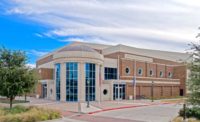High-Performance High

The entrance of the school. Image courtesy of Setty & Associates

Dunbar high school's gym. Image courtesy of Setty & Associates

The Media Center. Image courtesy of Setty & Associates

The backwash water from the pool is reused in the water harvesting system. Images courtesy of Setty & Associates




During August 2013, the country’s first predominantly African-American public high school reopened its doors as the new Laurence T. Dunbar High School. Originally founded in 1870 in Washington, D.C., the old school underwent a $122 million complete re-engineer and redesign creating a 276,536-square-foot high performance building earning a LEED for Schools Platinum certification. Dunbar’s new design features geothermal heating, photovoltaic (PV) panels, rainwater harvesting, and on-demand advanced lighting and ventilation controls. These efficiencies gained through engineering design have the potential to offer remarkable energy conservation results, considerable savings and inspiration by example.
Digging Deep
An integral piece of the design for Dunbar is the geothermal system. Geothermal systems have emerged to benefit longer lifespans for component parts; approximately 25 years for heat pumps and 50 plus years for ground loops. Compared to conventional HVAC systems, geothermal systems require minimal maintenance and have very low operating costs. Dunbar’s new geothermal system has a rated capacity between 850 to 1000 tons; the largest in Washington, D.C. The design of the vertical bore field is slated to rise less than 10 degrees over the next 30 years, and has been balanced to optimize thermal storage between the seasons.
The design includes 362 wells located 460 feet below the athletic field and is connected to multiple water-to-water heat pump and water-to-air heat pumps throughout the building. By using dedicated classroom based heat pumps, each heat pump will meet the specific needs of the space it conditions, optimizing energy efficiency and giving teachers control over their own learning environments. Importantly, when the classrooms go unoccupied or are partially occupied, the systems have a robust turndown capability, saving more energy and lowering the financial costs to the school. Furthermore, the ground source condenser loop is also connected to refrigeration equipment in the kitchen which has eliminated all air condensers and allows for the ability to re-capture the heat from these units and re-deploy it to other areas of the building.
Dunbar’s geothermal system will also provide radiant flooring in many of the school’s largest common areas. Heating this way means that no fans or air ducts are required and it provides a more constant ambient temperature. When compared to the average energy expenditures of other Washington, D.C. schools, the geothermal system and radiant heating will save D.C. Public Schools up to $300,000 annually.
Bright Ideas
A second key feature of the design was to take advantage of the approximately 200 sunny days Washington, D.C. has each year. Dunbar has three types of PV panels installed on its roof: trellis mounted, roof ballasted and thin film. It is estimated that the solar panels will produce about 480 kW of energy. As a point of comparison, lighting one classroom requires 1kw for one hour. The PV panels are anticipated to offset more than 21 percent of the school’s energy consumption.
Dunbar is also utilizing lighting control systems that allow for increased flexibility in lighting options and provide greater efficiency. Inside, the school has installed Lutron’s Quantum lighting controls that use daylight and occupancy sensors and motorized window shades paired with scheduling, digital ballasts and LED drivers to provide up to 60 percent savings in the school’s lighting usage. On the track and field area, Dunbar is using a lighting system by Hubbell Lighting, which allows the lights to be turned on at 25, 50, 75 or 100 percent intensity depending on the event.
Less Down The Drain
Through careful design the school’s water usage has been reduced by about 50 percent by instituting rainwater collection and installing more efficient water fixtures. There are two 20,000 gallon cisterns adjacent to the school that store rainwater harvested from the roof. All process loads and pool backwash water is reused in the water harvesting systems. The water is filtered and used for flushing the low-flow urinals and high-efficiency toilets. The school also features low-flow lavatories and ultra low-flow showers. As a result, it is anticipated that Dunbar will conserve approximately 1.4 million gallons of water per year compared to a typical large high school.
Inspiration by Example
Finally, Dunbar features a science, technology, engineering and mathematics (STEM) program that encourages and inspires students, especially those from disadvantaged backgrounds, to acquire the skills necessary to enter into positions leading to exceptional career paths. The new school also includes a living classroom, where students will be able to observe and learn first-hand about the features of high performance buildings and the importance of sustainable building design.
Looking for a reprint of this article?
From high-res PDFs to custom plaques, order your copy today!



.png?height=200&t=1731252754&width=200)




